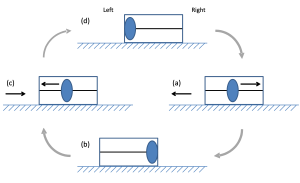Blog
Engine Fiction
16 October 2019
When a NASA engineer announces a new and revolutionary engine that could take us to the stars, it’s easy to get excited. But the demons are in the details, and when you look at the actual article things look far less promising.1
To begin with, the article is an outline of an idea, not peer reviewed work. As the author David Burns points out on the last page, the basic concept is unproven, hasn’t been reviewed by experts, and math errors may exist. Burns’ proposed “helical engine” would also be a reactionless drive similar to the EM-Drive, and so would violate Newton’s third law of motion. It would be easy to just dismiss the work and move on, but I’d like to look at the details because it’s an interesting (though flawed) idea.
Let’s start with reactionless drives in general. Both this Helical Engine and the EM-Drive before it are “reactionless,” because unlike traditional rockets and thrusters they don’t expel propellent. At their heart, all rockets are based upon Newton’s third law of motion, which says for any force you apply to your rocket there must be an equal counter-force applied to something else. For a rocket, that is some kind of fuel. Throw hot gas out the back end of your rocket at high speed, and by Newton’s Third Law the rocket moves forward. Easy peasy.
The problem with this is that in order to get your rocket going really fast, you have to carry a bunch of fuel with you. The Saturn V, for example, needed to burn about 20 kilograms of fuel for every 1 kilogram of payload just to reach the Moon. Things get worse the farther you travel. If you wanted to send a probe to the nearest stars, you’d need about 2,000 kilograms of fuel for every kilogram of payload, and your trip would still take 100,000 years. So it’s safe to say that traditional rockets won’t get us to the stars.
A reactionless drive is different. It would provide thrust to your rocket without throwing fuel out the back end, so you don’t need all that extra weight. All you need is power, which you could get from solar panels or a fusion reactor. The ratio of fuel to payload would be basically 1 to 1. The only downside is that reactionless drives violate Newton’s third law. Now, you might argue that Einstein proved Newton wrong, which is true, but Einstein’s theory of relativity agrees with Newton’s third law. So does quantum theory. If reactionless drives work, then three centuries of physics are wrong.
Fans of the EM-Drive argue exactly that. The EM-Drive works, they say, so Newton’s Third Law is wrong. Period. What makes this new Helical Engine interesting is that rather than simply violating Newton’s third law, it tries to play Newton against himself using relativistic mass.
 David Burns
David BurnsThe basic idea is to move a mass back and forth within a rocket, like bouncing a ball back and forth. If you did that with a normal mass, when the ball hits the front of the rocket, the rocket would move forward a bit, and when the ball hits the back the rocket would move back a bit. In other words, the rocket would just wobble forward and backward as the ball bounces back and forth. Burns proposes doing this with particles in a helical particle accelerator. So as the particles go up and down the helix, the rocket moves by Newton’s Third Law. But Burns also proposes accelerating the particles to near light speed as they are at the front of the rocket, and slowing them down at the back. Relativity says that particles moving near the speed of light have greater mass than slower particles, so they are heavier at the front of the rocket than at the rear. Going back to the ball analogy, this would be as if your ball magically gains mass before it hits the front of the rocket, and loses mass before it hits the rear. By Newton’s laws, this means the ball would give the rocket a bigger push forward than backward, and the rocket would accelerate forward.
 David Burns
David BurnsIf you could use a magical mass-changing ball, this idea would work. But relativity still obeys Newton’s third law, so the idea doesn’t work in the real world. Burns is right that there’s an error in his paper, but it’s a subtle one. His design only accelerates the circular motion of the particles, so he assumes their speed forward and backward along the axis of the rocket should remain constant. But in relativity, as the mass of the particles increase, their speed along the axis would slow down. This is due to the relativistic effects of time dilation and length contraction. As a result, the particles give the rocket an equal push at both ends. Einstein’s theories don’t let you get around Newton.
In fairness, Burns knew his idea was a long shot, which is why he put it out there for others to review. That’s what science is all about. That’s also why it’s worth getting just a little excited when ideas like this are put forward. Most of them will fail, but someday one just might work. We could get to the stars after all, but only if we’re willing to keep testing new ideas.
Burns, David M. “Helical Engine.” AIAA Propulsion and Energy 2019 Forum. 2019. ↩︎